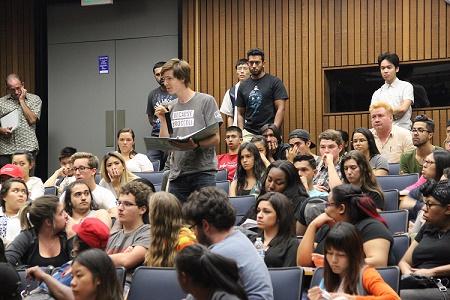CRC hosts first presidential debate viewing and discussion

Students take part in question-and-answer forum after presidential debate viewing in L-111 on Monday.
Tuesday night had the largest projected audience of a presidential debate in U.S. history, with an expected 100 million people viewing live.
The two candidates, Hillary Clinton and Donald J. Trump, went head-to-head on the most important issues the U.S. is currently facing: jobs, the economy, racial discrimination, cyber warfare and nuclear weapons.
The event was streamed live through CNN from Hofstra University to the Cosumnes River College’s campus lecture hall, L111, which was overflowing with so many students that there were not enough seats.
This is the third time CRC has covered a presidential debate, though some of the professors involved agreed that this one held the most significance.
“The purpose of this event on campus is to have a collective experience where we can watch and talk together,” said Political Science Professor and chair of the political science department Martin Morales. “The significance of this election is that it’s your future. You have a voice and hopefully you will exercise it in a manner which is fitting your belief system,” Morales said.
Professors from three different disciplines led a Q&A panel to give students a chance to understand the political process and to get professional answers. The panelists included Morales, U.S. History and Women’s History Professor Diana Reed and Communications Professor Georgine Hodgkinson.
Morales started the post-debate discussion with “I’ve never seen anything like this,” which was the mood for most of the discussion.
Hodgkinson said she had looked at 15 different polls that morning that showed slightly varied responses. “It’s safe to say that this is a really close race,” she said.
Reed focused on the gender perspective of the debate and the significance of nominating a woman to represent a major political party for the first time.
“100 years ago, women couldn’t vote, so I was really interested in how much gender would be an aspect of the debate,” Reed said. All three of the professors commented on the unique nature of this election.
“The most interesting poll I saw was a few days ago that said that 57 percent of Americans in this country either felt disgusted by or frustrated with the choices they had in this election,” said Hodgkinson.
“I’ve been studying presidential campaigns for a long time, and this has been one of the most interesting I’ve ever seen. It’s also been a really difficult campaign for me to watch, but sort of like a car crash – I cannot look away.”
Some students expressed uncertainty for the election and felt lost in deciding who to vote for.
“I’ve realized I can’t base my decision off of one source,” said 18-year-old liberal arts major Nick Burnau. “I have a long road ahead of me.” Burnau said he found it funny that people clapped at certain moments of the debate.
“It felt to me that they were clapping for all the wrong reasons,” Burnau said. “The candidates had pre-planned these ‘gotcha’ moments, and the audience fell for them by clapping. They fit into these spoon-fed artificial moments.”
Reed said her favorite part of the event was hearing input from the students.
“I was so overwhelmed by the interest of the students, by their questions, and they seemed so engaged as though they really cared about the issues,” Reed said.
Morales responded to the
students’ concerns when he said “the answer lies within you. What you do in the voting booth is nobody’s business. Do your research. But also, don’t lock yourself in a box. Make your own decisions.”
Reed concluded the event by urging students to vote, emphasizing the sacrifices Americans have made so that they could vote today.
“Your voice does matter,” said Reed. “Don’t give away your power. Don’t give away your voice. Please vote.”
